Mohammad Mhanna 1*; Ali Issa El-Khateeb 1; Hadya Hasan 2; Bashar Zahra 1; Monzir Al-kaady 1; Abeer Habib 1
1, General Commission for Scientific Agricultural Research (GCSAR), Latakia Center, Siano Research Station, Jableh, Syria
2, General Commission for Scientific Agricultural Research (GCSAR), Latakia Center, Al-Hinady Station, Latakia, Syria
E-mail:
agrihort@yahoo.com
Received: 29/01/2023
Acceptance: 03/04/2023
Available Online: 04/04/2023
Published: 01/07/2023

Manuscript link
http://dx.doi.org/10.30493/DAS.2023.383566
Abstract
A completely randomized blocks design experiment was conducted for eleven years at Siano research station, Jableh, Latakia, Syria in order to select a new rootstock for satsuma (Citrus unshiu Marc.) cv. ‘St-Jean’ plantations. Sour orange, Citrumelo 1452, Citrumelo 4475, Rangpur lime, Carrizo citrange, Troyer citrange, Trifoliate orange “Robidoux” and Volkamer lemon were used as rootstocks. Yield (kg/tree), trunk cross-sectional area (cm2) above and below grafting area, fruit weight (g), peel thickness (mm), juice content (%), titratable acidity (TA%), and total soluble solids (TSS%) were estimated. Depending on trunk cross-sectional areas, morphological compatibility was high between Satsuma and Rangpur lime, Sour orange, and Volkamer lemon, while it was low with Citrumelo 1452, 4475, and Trifoliate orange. Trees budded onto Sour orange gave the highest canopy volume, while trees buddied onto Trifoliate orange gave the lowest. On average, Satsuma buddied onto Citrumelo 1452 gave the highest yield (174 kg/tree), followed by those buddied onto Troyer citrange (167 kg/tree), Citrumelo 4475 (165 kg/tree), Volkamer lemon (163 kg/tree), and Sour orange (152 kg/tree) without significant variation among them. Canopy efficiency (kg/m3) was higher in trees buddied onto Trifoliate orange, while it was lower in those grafted on Sour orange. Mean fruit weight was close among all treatments, However, it was the lowest using Sour orange and Carrizo citrange, while no significant variations were found regarding peel thickness or juice content. No significant variations were found in TSS% between Citrumelo 4475, 1452, Carrizo, Troyer citrange, or Sour orange, while TSS% decreased significantly using Rangpur, Trifoliate, and Volkamer lemon rootstocks. Additionally, fruit titratable acidity and maturity index (TSS/TA) were not influenced by rootstock type. Due to its superiority in many of the studied characteristics, Citrumelo 1452 can be suggested as a suitable rootstock for satsuma in the studied area and areas with similar conditions as an alternative to Sour orange.
Keywords: Satsuma, Citrumelo, Canopy volume, Compatibility, Fruit quality, TSS
Introduction
Citrus is one of the most important fruit species around the world. In Syria, the area covered with Citrus reached 42654 ha with an annual production of 1.09 million tons, and Latakia as the main area of production [1].
Satsuma mandarin (Citrus unshiu Marc.) was originated in China and Japan, mainly in southern Japan, where environmental conditions are suitable for its cultivation. Satsuma is typically used for fresh consumption. Low heat requirements allowed early growth and maturity of satsuma compared to other citrus species [2][3]. However, due to its sensitivity to other biotic and abiotic stresses, different rootstocks are usually used to grant high fruit yield and optimum quality in satsuma orchards [4].
Sour orange (Citrus aurantium) was the most widespread rootstock used for citrus, due to its compatibility with most citrus species, as well as the high yield of trees grafted on this rootstock. However, its sensitivity to citrus tristeza virus lead to substituting Sour orange with new tolerant rootstocks adapted to different cultivation environments. In fact, between 2012 and 2017, new citrus plantations around the world began to use different rootstocks depending on their local conditions. Recent reports indicate that Californian plantations are currently using Carrizo citrange in 30% of the cultivated areas, while Sour orange is still being used in less than 1% of the new orchards. On the other hand, Ranjpur lime is the widely used rootstock in Brazil, while Trifoliate orange is used in Argentina, China, and japan. In Spain Forner-Alcaide (F-A 5) rootstock is used in new plantations, while in Italy Carrizo citrange is used in 60% of the newly planted orchards [5].
In Japan, Satsuma cultivar ‘Yamakawa’ gave significantly higher growth when grafted onto Ranjpur lime, Citrumelo, and Volkamer lemon compared to Trifoliate orange, and the highest yield was of Satsuma grafted onto Citrumelo [6]. In southwestern Turkey, Carrizo citrange, Citrumelo 1452, and Yuzo were the optimal rootstocks for Satsuma, and were recommended as alternatives to Sour orange in the eastern Mediterranean climates [7]. Poncirus trifoliata var. monstrosa “Flying dragon” gave lower canopy volume and significantly higher canopy efficiency of satsuma mandarin in Brazil and was recommended for high-density plantations [8]
In Syria, Sour orange is still the dominant rootstock in all nurseries. However, the sensitivity of this rootstock to citrus tristeza virus and the registration of this virus in Syria [9], creates the need to replace Sour orange with another suitable rootstock under Syrian cultivation conditions. Therefore, the main focus of the current study is to select new rootstocks for Satsuma mandarin as alternatives to Sour orange under Syrian cultivation conditions.
Materials and Methods
Study site
The study was conducted in the period from 2011 to 2021 at Siano research station, which was created in cooperation with the Food and Agriculture Organization (FAO) in Jableh, Latakia governorate in Syria. The area is characterized by a Mediterranean climate with wet cold winter and hot dry summer. The soil is clay, not calcareous with good content of organic matter (Table 1).

Plant material
Satsuma Citrus unshiu Marc. cv. St-Jean grafted onto eight rootstocks in 1980 using a 6×8 m spacing was studied. The used rootstocks were as follows:
- Sour orange (Citrus aurantium).
- Carrizo citrange.
- Troyer citrange.
- Citrumelo 1452.
- Citrumelo 4475.
- Trifoliate orange (Poncirus Trifoliate L.) “Robidoux”.
- Volkamer lemon (Citrus Volkameriana).
- Rangpur lime (Citrus limonia Osbeck).
Studied characteristics
Tree and grafting characteristics
The following characteristics were evaluated
- Canopy volume was determined according to the following formula

Where V: canopy volume (m3), r: canopy diameter, and h: canopy height [10]. The diameter of the canopy was determined as an average of two diameters, one was taken parallel and the other vertical to the trees row.
- The trunk cross-sectional area (cm2) was measured 10 cm above and below the grafting area. Canopy volume and Trunk cross-sectional area was determined in 2012 and 2019 seasons only.
- Tree yield (kg/tree).
- Canopy efficiency (kg/m3) = Tree yield/Canopy volume
- Canopy volume increasing rate (%) = [(Canopy volume 2019 – Canopy volume 2012) / Canopy volume 2019]x100
Fruit characteristics
In this assessment, 25 fruits (5 fruits from the eastern, western, northern, and southern sides of the tree, and 5 from the inside of the canopy) were used. The following characteristics were evaluated:
- Fruit mean weight (g).
- Peel thickness (cm).
- Juice content (%) = (juice weight / total fruit weight) x100
- Titratable acidity (TA%) by titration method as mentioned by [8].
- Total soluble solids (TSS%) using field refractometer.
- Maturity index: TSS/TA.
Experimental design and statistical analysis
The study was designed according to a completely randomized block design with four replications. Data were subjected to ANOVA and means were separated using Duncan’s multiple range test at a significance level of 0.05 using CoStat v. 6.400 statistical analysis software.
Results
Growth vigor and compatibility
Canopy volume
Satsuma trees budded onto Sour orange followed by Volkamer lemon had the highest canopy volume compared to other rootstocks in 2012 season, while canopy volume was significantly lower on Citrumelo 1452, Carrizo citrange, Rangpur lime, and Trifoliate orange without significant variations among them (Table 2). In 2019 season, the trees grafted onto Sour orange had the highest canopy volume, but without significant variation with the other rootstocks except for those grafted onto Trifoliate orange which gave significantly the lowest canopy volume. Generally, growth rates differed among the studied rootstocks during the period between 2012 and 2019 seasons. Canopy volume of trees budded onto Carrizo citrange increased by 46.3%, while trees budded onto Trifoliate orange increased by 8.9%, which indicates the different behavior of satsuma growth depending on the used rootstock.
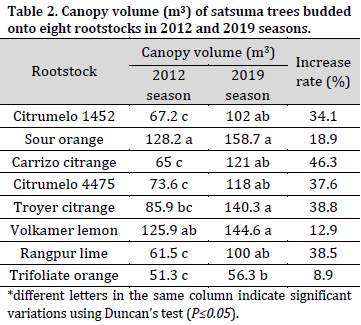
Trunk cross-sectional area (TCSA)
In 2012 season, Citrumelo 4475 had the highest TCSArootstock (898 cm2), followed by Citrumelo 4475 (804 cm2), while Rangpur lime had the lowest TCSArootstock (491 cm2). In 2019 season, Citrumelo 1452 gave the highest TCSArootstock (961 cm2) followed by Citrumelo 4475 (907 cm2), while TCSArootstock of Rangpur lime remained the lowest (518 cm2) (Table 3).
As for TCSA for scions, a significant variation was detected depending on rootstock type. In 2012, Sour orange resulted in the highest TCSAscion of Satsuma (711 cm2), while Trifoliate orange gave significantly the lowest TCSAscion (376 cm2). In 2019, the highest TCSAscion was observed in Volkamer lemon (836 cm2), and it was superior to all rootstocks except Sour orange (760 cm2).

Morphological compatibility between satsuma and the evaluated rootstocks
The ratio TCSArootstock/TCSAscion was used to evaluate the compatibility between rootstocks and satsuma scions. When the ratio was close to one, the morphological compatibility was considered higher (Table 3). The highest compatibility was observed on Rangpur lime (0.98-1.01). The same tendency was found when grafting satsuma on Sour orange and Volkamer lemon (Figure 1). The compatibility was medium on Carrizo and Troyer citrange, but noticeably weaker on Citrumelo 4475, 1452, and Trifoliate orange (Figure 1).
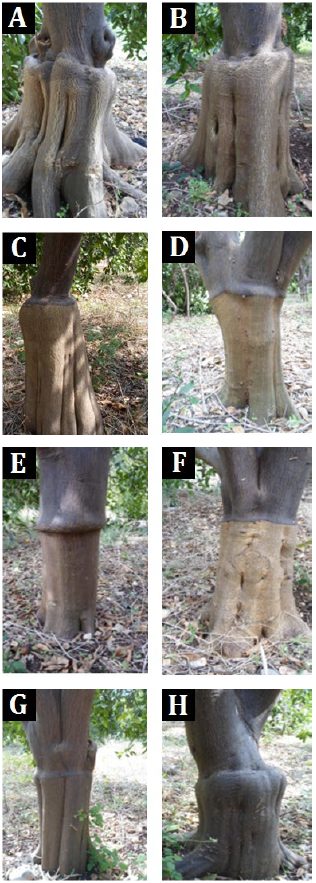
Yield
In 2011, satsuma trees budded onto Citrumelo 1452 had significantly the highest yield per tree (281 kg/tree) which was superior to the yield of satsuma trees budded onto Carrizo citrange (176 kg/tree), while the rest of the rootstocks produced yield between these two values. In 2012 and 2013 seasons, no significant differences among all studded rootstocks were found, while in 2015, Satsuma budded onto Sour orange had the highest yield (238 kg/tree), while trees budded onto Trifoliate orange had the lowest yield (67 kg/tree). In 2017, trees budded onto Citrumelo 1452 had the highest yield (273 kg/tree). A decrease in yield per tree was observed in all rootstocks in 2018, followed by an increase in 2019, where trees budded onto Citrumelo 1452 gave the highest yield (236 kg/tree).In 2020 trees budded onto Citrumelo 4475 gave the highest yield (102 kg/tree), while trees budded onto Trifoliate orange did not produce any commercial yield. Trees budded onto Citrumelo 1452 gave the highest yield in 2021 (164 kg/tree).
On average, satsuma budded onto Citrumelo 1452 produced the highest yield (174 kg/tree), followed by Troyer citrange (167 kg/tree), Citrumelo 4475 (165 kg/tree), Volkamer lemon (163 kg/tree), and Sour orange (152 kg/tree) without significant variations among the mentioned rootstocks. However, trees budded onto Carrizo citrange, Rangpur lime, and Trifoliate orange gave the lowest yields (Table 4).
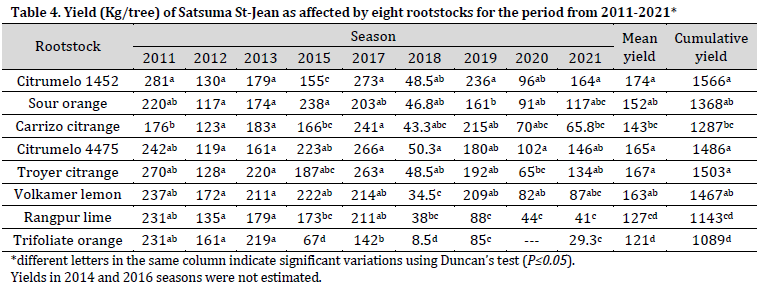
Canopy efficiency
The results showed that trees budded onto Trifoliate orange had the highest canopy efficiency (3.12 and 1.23 kg/m3) in 2012 and 2019, respectively. On the other hand, canopy efficiency of trees budded onto Citrumelo rootstocks were good in both seasons comparing to other rootstocks, while trees budded onto Sour orange gave the lowest canopy efficiency (1.23 and 0.23 kg/m3) in 2012 and 2019, respectively (Table 5).
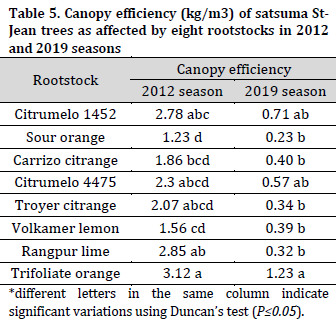
Fruit characteristics
Although the fruit weight of satsuma budded onto Trifoliate orange (88.9 g) was superior to trees budded onto Sour orange (79.5 g) and Carrizo citrange (77.2 g), no significant variations among the other rootstocks were observed (Table 6).
Fruit peel thickness appeared to be not influenced by rootstock type, since no significant differences were observed among fruits produced on different rootstocks. Similarly, no significant differences were observed in juice content, which ranged between 41.2% on Troyer citrange and 44.4% on Citrumelo 1452 (Table 6).
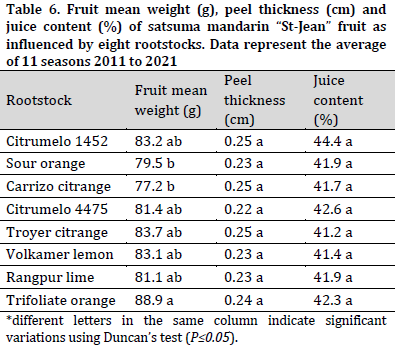
Juice characteristics
Total soluble solids (TSS) values were similar among the majority of rootstocks; however, TSS of satsuma fruit juice in trees budded onto Carrizo citrange (11.4%), Troyer citrange (11.2%), Citrumelo 4475 (11.4%) and Sour orange (11.2%) was superior to the TSS of those budded onto Volkamer lemon (9.8%), Rangpur lime (10.5%) and Trifoliate orange (10.4%) (Table 7).
As for Titratable acidity (%), no significant differences among the studied rootstocks were observed, and TA% ranged from 1.04% on Volkamer lemon and Rangpur lime to 1.24% on Troyer citrange. Similarly, rootstock type had no significant effects on the maturity index (TSS/TA) which ranged from 9.03 to 10.2 (Table 7).

Discussion
In this research, eight citrus rootstocks were evaluated for their effect on satsuma (Citrus unshiu) cv. “St-Jean” growth and yield. Rootstocks significantly affected tree growth including canopy volume and trunk cross-sectional areas of scion and rootstock. Several studies reported similar results and effects on tree growth when using different rootstocks [6-11]. In fact, rootstock type can influence the expression of genes involved in the transmission of auxin signals, and the biosynthetic pathways of gibberellins [12]. Thus, rootstocks can regulate the levels of hormones and their pathways affecting the growth of grafted plants [12]. Regarding morphological compatibility between trunk cross-sectional areas of scions and rootstocks, the results are in accordance with [7] who found a match in rootstock and scions stem circumference of clementine mandarin budded onto Sour orange and Rangpur lime.
Rootstock type affected the yield of satsuma, and the highest yield (cumulative and average) was observed in trees budded onto Citrumelo 1452 with this rootstock maintaining a high yield throughout the study period. Many studies mentioned the significant effect of rootstock on citrus yield [8][13][14]. Similar to the current results, the highest yield of ‘Okitsu’ Satsuma was observed when crafting onto “Swingle” Citrumelo in Brazil, while the lowest yield was observed on Carrizo citrange rootstock [14]. Although most satsuma plantations use Trifoliate orange as a rootstock [15], the last 4-5 years of the current study showed a gradual decline in yield when using this rootstock. Therefore, selecting other rootstocks in new plantations might be more suitable for long-term production.
As for fruit characteristics, Trifoliate orange gave the highest fruit weight for “St-Jean” satsuma which contradicts the results of [16] who reported that Trifoliate orange produced smaller fruits of ‘Shatangju’ mandarin due to a higher concentration of abscisic acid in the fruits, which inhibited cell division and fruit growth. The conflicting results could be related to the lower fruit yield of satsuma budded onto Trifoliate orange in the present study (Table 5), which resulted in lower competition for assimilates between fruits compared to other rootstocks with higher yields.
As for fruit characteristics, rootstock appeared to have no influence over peel thickness or Juice content of Satsuma fruits, which agrees with [14] as they found no significant variation in juice content of ‘Okitsu’ Satsuma budded onto Rangpur lime, Volkamer lemon, Carrizo citrange, or Trifoliate orange. However, Satsuma fruits are consumed fresh in Syrian markets, thus, juice content could be less important in this situation.
Total soluble solids content (TSS%) was acceptable using all rootstocks. However, an obvious reduction of TSS was observed with Rangpur lime, Trifoliate orange, and Volkamer lemon rootstocks. This observation is in accordance with previous reports where fruit juice TSS in trees budded onto Rangpur lime was significantly lower compared to those budded onto Carrizo citrange and Trifoliate orange [14]. As for TA%, no effect of rootstock was detected, which was partially in accordance with [17] since they found no significant variation in titratable acidity of ‘Shirakawa’ Satsuma budded onto Trifoliate orange and Troyer citrange. TSS/TA could determine fruit maturity as well as fruit taste (the higher TSS/TA is correlated with sweeter fruit). In the present study, no significant differences in TSS/TA were observed between the used rootstocks; however, Citrumelo 1452 had the highest TSS/TA ratio.
Conclusions
Although traditional rootstocks were used in the present study, this is the first report of a long-term assessment of citrus rootstocks in Syria. In light of the present results, it could be concluded that ‘St-Jean’ Satsuma had a better performance when budded onto Citrumelo 1452 due to the higher yield and fruit quality obtained using this rootstock compared to other studied ones. Additionally, this rootstock is tolerant to Tristeza virus compared to Sour orange. Therefore, Citrumelo 1452 might be recommended as a suitable rootstock for satsuma plantations in conditions similar to the present study, especially in non-calcareous soils, since this rootstock is not tolerant to calcareous soils.
References
| 1 | Ministry of Agriculture and Agrarian Reform (MOAAR)- Directorate of Planning and Statistics, Division of Statistics. Syria. 2019. |
| 2 | Andersen PC, Ferguson JJ, Spann TM. The satsuma mandarin. University of Florida 2019. |
| 3 | Stein LA, Parsons JM. ‘Miho’and ‘Seto’—New High Quality Satsumas For Texas. Subtrop. Plant Sci. 1998;53:16-8. |
| 4 | Bitters WP. Citrus rootstocks: Their characters and reactions. Riverside, CA: UC Riverside Science Library. 1986. |
| 5 | Bowman KD, Joubert J. Citrus rootstocks. In The genus citrus. Woodhead Publishing. 2020:105-27. DOI |
| 6 | Noda K, Okuda H, Kihara T, Iwagaki I, Kawase K. Effects of rootstocks on tree growth and fruit quality in very early ripening satsuma mandarin ‘Yamakawa’. J. Japan. Soc. Hort. Sci. 2001;70(1):78-82. |
| 7 | Tsakelidou K, Papanikolaou X, Protopapadakis E. Rootstock effects on the yields, tree and fruit characteristics of the mandarin cultivar ‘Clementine’on the Island of Rhodes. Exp. Agric. 2002;38(3):351-8. DOI |
| 8 | Cantuarias-Avilés T, Mourão Filho FD, Stuchi ES, da Silva SR, Espinoza-Núñez E. Tree performance and fruit yield and quality of ‘Okitsu’Satsuma mandarin grafted on 12 rootstocks. Sci. Hortic. 2010;123(3):318-22. DOI |
| 9 | Kubaa RA, Djelouah K, D’Onghia AM, Addante R, Jamal M. First Report from Syria of Citrus tristeza virus in Citrus spp. Plant Dis. 2008 Oct;92(10):1468. DOI |
| 10 | El-Khateeb A. Effect Caco3 Content In The Soil On Growth Of Some Citrus Rootstocks And The Tissue Content Of Elements. Doctoral Thesis. Tishreen University. Syria. 2001. |
| 11 | Hayat F, Li J, Iqbal S, Peng Y, Hong L, Balal RM, Khan MN, Nawaz MA, Khan U, Farhan MA, Li C. A mini review of citrus rootstocks and their role in high-density orchards. Plants. 2022;11(21):2876. DOI |
| 12 | Liu XY, Li J, Liu MM, Yao Q, Chen JZ. Transcriptome profiling to understand the effect of citrus rootstocks on the growth of ‘Shatangju’mandarin. PLoS One. 2017;12(1):e0169897. DOI |
| 13 | Ramin AA, Alirezanezhad A. Effects of citrus rootstocks on fruit yield and quality of Ruby Red and Marsh grapefruit. Fruits. 2005;60(5):311-7. DOI |
| 14 | Tazima ZH, Neves CS, Yada IF, Leite Júnior RP. Performance of’ Okitsu’ Satsuma Mandarin on nine rootstocks. Sci. Agric. 2013;70:422-7. DOI |
| 15 | Kawase KE, Iwagaki IS, Takahara TO, Ono S, Hirose K. Rootstock studies for citrus varieties in Japan. Jpn. Agric. Res. Q. 1987;20:253-9. |
| 16 | Liu X, Li J, Huang M, Chen J. Mechanisms for the influence of citrus rootstocks on fruit size. J. Agric. Food Chem. 2015;63(10):2618-27. DOI |
| 17 | Takahara T, Ogata T, Fujisawa H, Muramatsu N. Effect of rootstocks on tree growth, yield and fruit quality of ‘Shirakawa’satsuma mandarin (Citrus unshu Marc.). Bull. Natl. Inst. Fruit Tree Sci. (Japan). 2001. |
Cite this article:
Mhanna, M., El-Khateeb, A., Hasan, H., Zahra, B., Al-kaady, M., Habib, A. Selecting a new citrus rootstock for Satsuma (Citrus unshiu Marc.) in the Syrian coast. DYSONA – Applied Science, 2023;4(2): 42-50. doi: 10.30493/das.2023.383566
